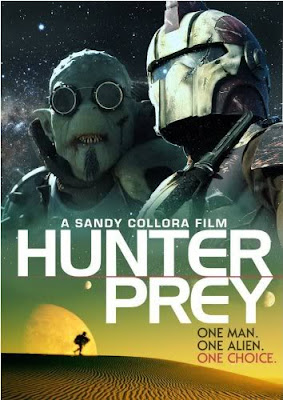Strange Behavior (aka: Dead Kids) (1981) With an emphasis on story rather than cheap thrills, this isn’t your typical early 80s slasher flick. Strange Behavior was filmed in New Zealand, but the setting is mid-America. Male high school students are being recruited for psychological experiments by the local university, resulting in homicidal extra-curricular activity. The experiments are being conducted by an unscrupulous researcher (Is there any other kind in this type of movie?), played with an unhinged zeal by Fiona Lewis. Apparently, she never heard about the concept of informed consent, but if her subjects truly knew the risks they would never have agreed to the experiments in the first place, and there wouldn’t be a story. The film doesn’t do much to dispel the notion that psychological experimentation is inherently evil, with ideas that are more pop-psychology than real science. I have to grant kudos, however, to screenwriters Bill Condon and Michael Laughlin (also the film’s director) for acknowledging Dr. Watson’s early behavioral experiments, and mentioning operant conditioning. Sadly, they failed to mention B.F. Skinner, who was really instrumental in taking research in this field to another level, but that’s probably asking too much from a movie that’s basically a dead teenager popcorn flick. It’s an interesting little entry in the horror genre, and definitely merits a look if you can find it.
Rating: ***. Available on DVD.
Eolomea (1972) The East German DEFA Studios-produced Eolomea provides a rare peek at Iron Curtain-era sci-fi. If you can get past the dated fashions, funky music and obligatory romantic scenes depicting lovers running on a secluded beach, it’s a unique and thought-provoking relic. Unlike many of its Western counterparts, Eolomea is not about non-stop action scenes, or space battles, or sweeping effects-laden vistas. While talky by Western standards, it’s a true science fiction film that’s more interested in ideas than action. Set in the not-too-distant future, space exploration is now an international venture, presided over by the United Nations. After several deep space vehicles and their crews go missing, a ban is implemented on further missions. Humanity is left with a dilemma that weighs the perils with the benefits of continued space exploration. Will ideals win out over bureaucratic meddling? Considering Eolomea’s communist origins, it was surprising to see the theme of individual initiative prevailing over majority rule cast in such a positive light. While visuals are not the film’s strong point, they do not detract from the overall experience. Although the sets and model effects seem quaint and antiquated by today’s standards, it’s evident that a lot of thought was put into the appearance of the spacecraft interiors, and the spacesuits look functional. One low point (or high point, depending on your point of view) to watch for is a goofy robot that could have been the inspiration for Conky 2000 from Pee Wee’s Playhouse. The word of the day is Eolomea!
Rating: *** ½. Available on DVD.
Alien vs. Ninja (2010) With a title like Alien vs. Ninja, you can’t expect very much, beyond a marginal level of competence on the part of the filmmakers and an excuse to see a goofy mismatch from different genres. Sadly, it fails to live up to even this diminished level of expectations. Thanks to low budget and lower aspirations, I was never convinced that I was watching a period piece, but watching cosplay set in some vague time and place. My knowledge of Japanese culture prior to the 20th century is a little thin, based largely on Kurosawa films, so I’m not the best judge of authenticity, but somehow I find it hard to believe that ninjas living in feudal Japan had earrings, tribal tattoos or bleached hair. The story, what there is of it, is sidetracked by feeble attempts at humor and the plot consists of non-stop fighting scenes to the point of monotony. I caught myself nodding off at least once, but thanks to the flimsy plot, ham-fisted acting and cardboard characters, I had no problem keeping up with what was happening. The alien costumes probably wouldn’t pass muster at Comic-Con, looking like a bargain basement knockoff of Giger’s original design. Is it worth watching? If you really need to see low-rent aliens fight ersatz ninjas without the encumbrance of plot or characterization and you keep your standards sufficiently low, then go for it. I think I’ll pass.
Rating: **. Available on DVD, Blu-Ray and Neflix Streaming.
Hunter Prey (2010) Hunter Prey was the feature debut from director/co-writer Sandy Collora, best known for the clever shorts Batman: Dead End and World’s Finest . Interplanetary war is the backdrop, as two species square off against each other in a fight for survival on a desolate alien world. This is familiar territory, and there’s a distinct sense of déjà vu watching Hunter Prey, which borrows extensively from Star Wars, Star Trek, Enemy Mine (which is referenced), and dozens of other sci-fi films and television shows. Even well-worn tropes can seem fresh if handled appropriately, and Collora injects some life into the film with his sense of visuals. He gets a lot of mileage out of the effects and camerawork, considering the film’s tiny budget. The Mexican desert is also a fitting substitute for an extra-terrestrial landscape, even if the characters seem to be meandering around the same small patch of land for the entire movie. In a nod to sci-fi geeks everywhere, Erin Gray of Buck Rogers fame adds a nice little touch as a computer voice. Collora’s story, however, is a little too generic, with dialogue that’s little more than constant bickering between the handful of characters, and an abrupt, unsatisfying ending that just doesn’t make much sense. Collora was probably setting things up for a sequel, but I hope not. Perhaps Hunter Prey is best viewed as a dress rehearsal for something better down the line.
Rating: ** ½. Available on DVD and Netflix Streaming.






















